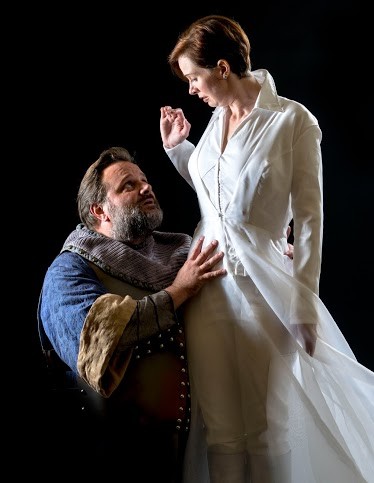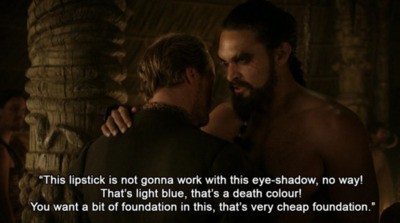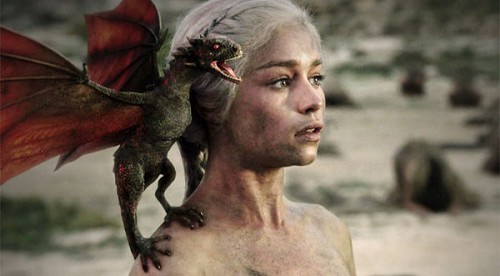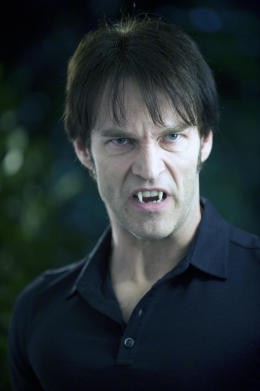 Photo: Joey Miller.
Photo: Joey Miller.
Dan McCleary as Richard and Caley Milliken of the Spirit World in TN Shakespeare Company’s production of RICHARD III playing at GPAC October 30 – November 1 at 7:00 pm. Children admitted FREE with paying, attending guardian. Box Office: 759-0604; tnshakespeare.org.
It’s almost Halloween, and as good a time as any to talk about dry old bones that have come back to haunt the living. Also, given the wild success of contemporary TV shows like Game of Thrones and this season’s installment of American Horror Story, set against the backdrop of a mid-20th-Century freakshow, the cultural stage couldn’t be more perfectly set for a reconsideration of Shakespeare’s gruesome historical tragedy, Richard III. And that’s exactly what the Tennessee Shakespeare Company will be providing in an extremely limited run (October 30-Nov 1) with TSC’s founding director Dan McCleary starring as the deformed and determined soldier who would be king.
It’s almost as if the spirit of the last Plantagenet called out across the centuries, begging to have his twisted bones exhumed from an anonymous grave. In September, 2012, a team of archeologists from the University of Leicester, working with the Richard III Society, broke ground in a parking lot poured over the site where Greyfriars Friary Church once stood. On the very first day of the dig the team discovered human remains. It was the body of a smallish man in his 30’s with a number of wounds, some clearly inflicted after death. The most compelling physical feature was a spine, severely twisted by scoliosis. Over time it became clear that the team’s first discovery, in the first hole they dug, was the body of Richard III, best known to the world by way of Shakespeare’s tale of a murderous hunchbacked villain who slaughtered anybody who stood between him and the throne. Shakespeare’s play presents an image of the King the historical society responsible for unearthing the remains has long dismissed as Tudor propaganda. Earlier this week I talked to McCleary about his approach to playing Richard, and the degree to which information drawn from the newly-discovered bones combines with current pop cultural fascinations to inform how the historical horror story might be understood by contemporary players and audiences.
Intermission Impossible: This is one of Shakespeare’s longest plays and one of his most demanding roles. I can’t even imagine how you can run the company, keep up with young twin boys, and rehearse this part. How are you holding up?
Dan McCleary: The boys just came to tech rehearsal last night. They’re really interested in this cartoon called Mike the Knight. I wear some pretty full armor on my torso for the duration of the play and so thay became immediately interested. They wanted to know why I wasn’t wearing a visor or a helmet. It wasn’t about Shakespeare for them.
This isn’t my first time to play Richard. I played him once before when I wasn’t this old and tired and grisled. It’s been 17 years and I was very different then, in a very different take on the play. So yes I did know what it would likely mean to do the part again and that’s why brought in a long time associate David Demke to direct, so I could feel like I had confidence in that area. I wanted to surround myself with some folks who were quick studies and knew the play.
It’s a short run, at least.
It’s a strange schedule you know? It’s more like an opera or a concert. One of the originations of Halloween is a reconsideration of saints or souls, so when GPAC had a few days available over Halloween I seized on that, and also the fact that Richard’s actual remains are still are above ground right now. I thought it was a perfect confluence of creative impulses they came together. In terms of schedule we’d love to run for two or three weeks obviously but it’s fitting quite nicely on the stage.
I’m glad you brought up the bones. There’s been a lot of contention regarding the historical Richard III. Does having seen the remains change how we see the play? And how it’s performed?
I think it does. I really should only speak for myself. But it has for us and it’s one of the questions at the heart of what we’re doing. As Shakespeare was writing England into being he knew very well who his monarch was. He was writing for the Tudors, and as we know, history is written by the winners. Also, Shakespeare is writing at at a time when there is a true and genuine belief, not just a religious belief but a humanist belief, that what’s on a person’s outside was the stamp of God. And because it was a stamp of God they were the same on the inside. We know Richard was not buried as a monarch. He wasn’t buried as a king or with any blessing or ceremony. Shakespeare wrote about a withered hand, and he didn’t have one. What may have made him a smaller person of 5’1” or 5’2” was, quite likely, the onset of scoliosis at the age of 10, which twisted his back quite painfully, and visibly into the shape of the letter C. That wouldn’t have prevented him from being a fierce warrior, but it would’ve forced him to find a way to breathe differently. To reorganize his internal organs. To walk differently. To fight differently. To approach life differently, maybe like the elephant man. We’ve considered those things, and we spent a lot of time looking at people who do indeed live through this. It forced us to come to terms with some of Shakespeare’s writing with an overlay of Richard’s bones.
It does humanize the monster.
Instead of creating a vice or a morality play, or some monster or creature, we’re considering who the man had to be considering the humanist and religious thoughts about what people look like on the outside, and how he was born, which is talked about very explicitly in Shakespeare’s play. We have to consider any horse accident he may have had after the age of 10 and everything he had to do to live, not just physically, but psychologically as well. He was a child born into war. He called himself deformed, and yet he was the most fearsome warrior there was. So we’re trying to figure out what might make him so.

The face of evil?
So the remains suggest a more sympathetic view?
The remains force us to look at is what Shakespeare created for Richard in acts 4 and 5, which is a subconscious, his waking dream when the ghosts visit. There’s a lot of fun working toward Richard becoming King. But there’s about six beats of silence in one of the first lines after he becomes King. He only gets six beats of happiness as king and then he’s already thinking about having to kill a child or children. So with the remains being above ground the impact on our production, so far, has been more heartbreaking than harrowing and more painful than Machiavellian.
Audiences seem more familiar with Richard III than they are with the other History plays.
The monster that Shakespeare was writing for the Tudor family made it a very popular play for 400 years. It’s easy to make into a fun story about a monster but I’m not quite sure that’s what Shakespeare intended, especially as we get to his fourth and fifth acts where we are able see the actual man. And then there’s the remains. Eleven wounds to the body. Nine to the head. Two of them lethal. And then there are the wounds inflicted on the body after he was dead, the shaming wounds. And the body unceremoniously dumped into a mass grave.
You know, right or wrong, good or bad, they’ve decided legally to give him a ceremonial burial in the spring. So that informs us as well.
Original Game of Thrones: Tennessee Shakespeare’s Dan McCleary Talks Richard III
I know your production isn’t directly informed by Game of Thrones or American Horror Story. But it seems to me, given the huge popularity of these kinds of TV shows, that the time is absolutely ripe for bringing Richard back. He’s so clearly an inspiration for the GOT character Tyrion Lannister. Even shows like Walking Dead force us to confront a dark side born of circumstance. So, do you think that these trends in pop culture also shape how we experience Richard?
I don’t watch those shows so I can’t say. We always want to create something through Shakespeare the talks directly to our Memphis audience about time and about geography. We want immediacy, urgency, and relevance. This might not be something that’s as Memphis-flavored as our [Taming of the] Shrew. But the bones being aboveground is what excites. We’re going to have a reconsideration of Shakespeare’s Richard with this overlay of natural history. And we’re going to find ways to visualize that. In regard to pop culture, there’s a fascination and always has been a fascination with perceptions of human evil. How can someone do such a thing to someone else? Or to themselves? Something we do I find, as humans, is attempt to not to just be a spectator, but to understand it. We don’t just pay five dollars to go and see the bearded lady, but to find out what it means for us. You know, I’ve killed a fly before. I’ve done something mean. That’s basically the foundation and Shakespeare is really the first playwright to be fascinated by this and to investigate.
He also knew human nature and our sick attraction to oddity. In The Tempest, which he writes much later, he says that people who “will not lay out a droit to relieve a lame beggar” will pay good money to see “a dead indian.”
Well, he was a marketing guy too. He was a business owner and he knew what would bring audience to the theater. And I don’t blame him at all for that. But really, Richard was probably presented as a morality play, and, to me, that seems like a foreign kind of theater and a form that’s already settled its case. This way there are more unknowns involved. I much prefer that.
Richard III is at GPAC Oct. 30-Nov. 1.



